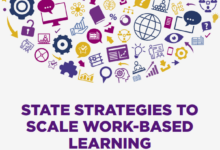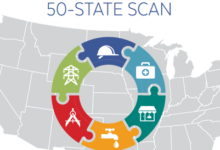In 2014, Delaware began building its capacity to increase postsecondary attainment by joining the Pathways to Prosperity Network. Following this step, then-Governor Jack Markell convened leaders from K-12 education, higher education, business, and community organizations to discuss a cohesive career pathways system in the state. The work of the convened group led to the Delaware Pathways initiative, a regional strategy to scale high-quality career pathways and improve connections between K-12 educational institutions and local employers.
Delaware Pathways’s strategic plan outlines five priority areas, with each priority area led by key representatives from government departments and the nonprofit and philanthropic sectors. These priorities and their leads include:
- Building a comprehensive system of career preparation that aligns with the needs of the state and regional economy.
- Delaware’s Department of Education (DDOE) was tasked with developing a model of continuing education and career preparation that spans the K-14 and postsecondary education systems. By December 2019, DDOE expects that 65 percent of students projected to exit high school will transition into postsecondary education and/or employment.
- Scaling and sustaining meaningful work-based learning experiences for students.
- Delaware Technical Community College (Delaware Tech) was tapped as a statewide workforce intermediary to link educators and employers, and scale work-based learning experiences for secondary and postsecondary students. By December 2019, 25 percent of projected grade 12 student enrollment and 30 percent of projected grade 13-14 student enrollment is expected to participate in a WBL course.
- Integrate workforce development efforts and data systems across state agencies, service providers, and the employer community.
- The Delaware Department of Labor (DDOL) is partnering with various state agencies and service providers to align education and workforce efforts under the Workforce Innovation and Opportunity Act (WIOA). Placing an emphasis around equity and access, the Pathways initiative is expected to impact more than 3,000 students with disabilities and 7,000 economically disadvantaged students by the end of 2019.
- Coordinate financial support across various sectors.
- United Way of Delaware & Rodel Foundation of Delaware are working across the public, private, and philanthropic communities to garner ongoing financial support necessary to implement and scale the Delaware Pathways initiative throughout the state. The goal is that by the end of 2019, 40 percent of funds ($4 million) will come through private and/or external funding sources, while 60 percent will come through public sources.
- Communicate and engage employers, educators, and service providers.
- The governor’s office is working with the Delaware Workforce Development Board (DWDB) and partnering state agencies to collaboratively develop a communication strategy to expand visibility, facilitate public support, and establish a brand for Delaware Pathways.
The leadership team also took steps to formalize their governance structure in 2016. That same year, Governor Markell signed an executive order defining Delaware Pathways as “a collaborative workforce development partnership” and designating a Steering Committee to oversee key aspects of the initiative’s implementation. The Committee now consists of 14 members, including the cabinet Secretaries of Education, Labor, Economic Development, and Health and Social Services; the chair of the Delaware Workforce Development Board; the president of the State Board of Education; two school system superintendents; two business representatives; three members of community organizations; and the president of Delaware Tech, who was appointed chair of the Committee. The leadership team also provides bi-annual updates to partners on the initiative’s progress and necessary next steps. These strategic conversations, anchored in data, are the mechanism through which the initiative drives coordination and implementation across the state.
Policy In Action
Delaware Pathways has grown exponentially since its inception. In 2019-2020, approximately 40 percent of high school students (16,000 learners) were enrolled in a Delaware Pathway program, compared to just 13 percent participating in the career pathway system over the 2015-16 school year. At the same time, the leadership team is expanding relationships with participating businesses, community partners and schools. In 2018, 42 high schools offered 157 career programs aligned to Delaware Pathways and the number of businesses providing work-based learning has increased rapidly with over 80 companies entering Delaware’s online portal (SPARC).
While the initiative has been successful so far, the leadership team faces several salient challenges moving forward. Many of these challenges relate to the team’s ability to secure funding — particularly state funding — to meet future programming needs. Partners have been effective at using federal and private funds to support and expand the initiative, but the state’s budget deficit has limited a steady stream of state funds needed to expand the Pathways infrastructure. Another challenge that the leadership team faces as they scale Delaware Pathways is students’ ability to complete college-level work. In 2016, 40 percent of Delaware high school graduates were required to take remedial coursework in college. How the state is navigating this challenge is yet to be seen.
The leadership team recognizes many of the initative’s challenges, however, and is currently assessing strategies to both effectively scale and meet the needs of the student and employer community in the state.
Related Links
Report: Delaware Pathways Priorities
Report: Delaware Pathways Strategic Plan
Report: Delaware Pathways Outcome Report
Memo: Progress Update Memo – January 2018
News: Delaware Pathways Receives $3.25 Million Grant
Snapshot: Delaware 2017 New Skills For Youth Progress
Snapshot: Delaware 2018 New Skills For Youth Progress
Executive Order: Delaware Pathways Steering Committee
Case study: The Role of Strategic Partnerships in Scaling Delaware Pathway
Last Updated March 2021





